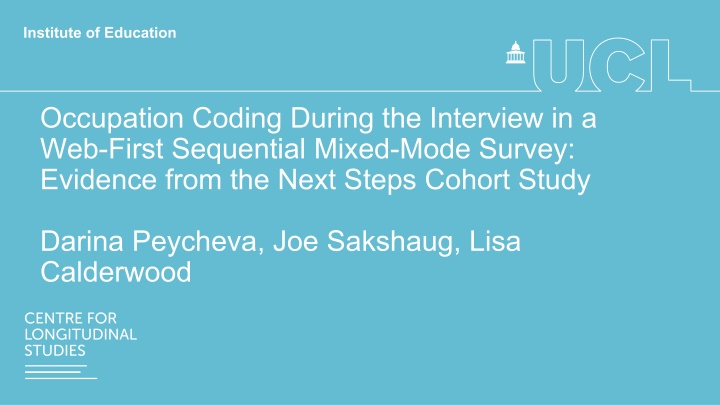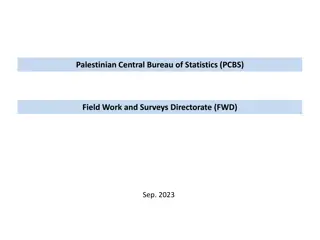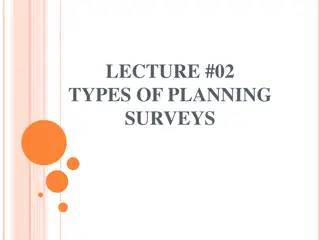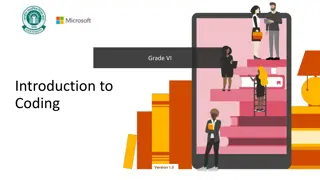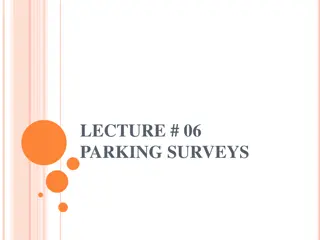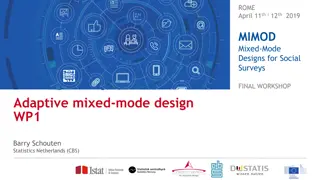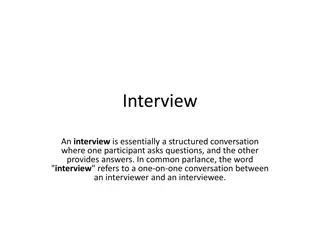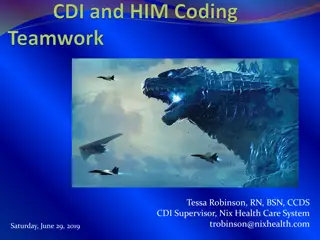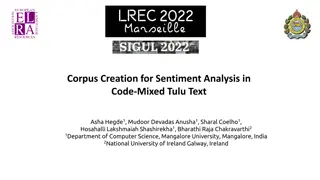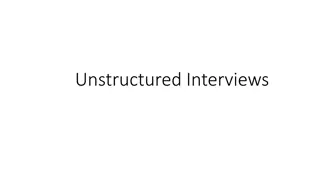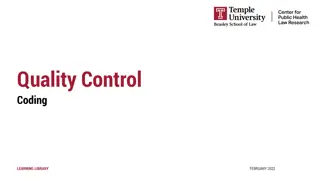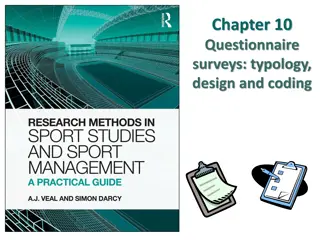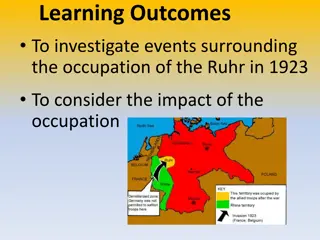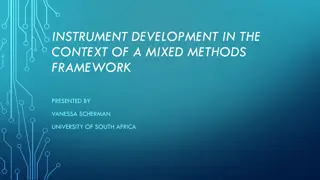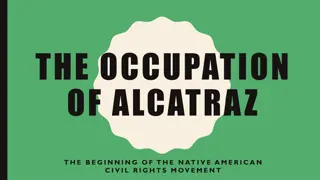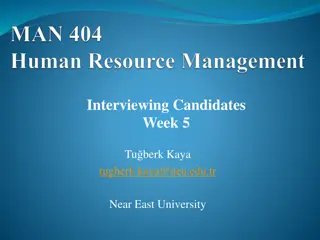Enhancing Occupation Coding Efficiency During Interviews in Mixed-Mode Surveys
Explore the benefits of coding occupation data during interviews in web-first mixed-mode surveys. Previous research suggests reduced errors, improved data quality, and cost/time savings. The practice involves open-ended questions, manual or computer-aided coding, and potential interviewer advantages over post-interview coding. Plans for improving coding strategies in future surveys are also discussed.
Download Presentation

Please find below an Image/Link to download the presentation.
The content on the website is provided AS IS for your information and personal use only. It may not be sold, licensed, or shared on other websites without obtaining consent from the author.If you encounter any issues during the download, it is possible that the publisher has removed the file from their server.
You are allowed to download the files provided on this website for personal or commercial use, subject to the condition that they are used lawfully. All files are the property of their respective owners.
The content on the website is provided AS IS for your information and personal use only. It may not be sold, licensed, or shared on other websites without obtaining consent from the author.
E N D
Presentation Transcript
Occupation Coding During the Interview in a Web-First Sequential Mixed-Mode Survey: Evidence from the Next Steps Cohort Study Darina Peycheva, Joe Sakshaug, Lisa Calderwood
Outline 1) Occupation coding general practice 2) Occupation coding during the interview - past research 3) Occupation coding during the interview evidence from the Next Steps Age 25 Survey 4) Plans for coding occupation in the Next Steps Age 32 Survey
Occupation coding general practice Series of open-ended questions asking participants for their job title and to describe the kind of work they do dominate the research practice Enable to collect sufficient detail and assign a code at the most detailed level of the occupational classification Administered in both interviewer- and self- administered settings, including mixed mode surveys o Less often occupation is captured with closed-ended questions offering limited choice of categories and resulting in highly aggregated codes; o Search tree navigation and semantic text matching techniques, and look-up methods used in web-surveys Verbatim responses (to open-ended questions) typically coded post-interview by specialist coders using manual or computer aided (assisted or automated) coding Use of manual coding significantly reduced but still complements computer aided coding methods even though the challenges it poses (e.g. time consuming, costly and error prone).
Occupation coding (of open ended questions) during the interview Previous research has acknowledged the potential of coding occupation during the interview o Potential for reduction in coding errors as uncertainties likely to arise post-interview, due to insufficient or contradictory information, can be resolved by the interviewer o Easier for the interviewer to probe for additional information during the interview than it is for any post-interview intervention o More parsimonious list of best matching occupations to choose from, and allow the coding decision to be confirmed by the respondents themselves o Assumed that interviewers do not achieve the same levels of accuracy as specialist coders, with increasing experience the interviewer may develop a better idea of what constitutes a good occupational description and probe accordingly o Expected to reduce costs and processing time since a smaller number of occupation descriptions will require post-interview coding. o Low maintenance costs as the code frame and search algorithms can be constructed and updated automatically.
What is known about its feasibility (already) Effective implementation in a few interviewer-administered (telephone and in-person) surveys (Hacking et al. 2006; Brugiavini et al. 2017; Schierholz et al. 2018) o Coding rates between 72% and 80% o Limited but positive insights about data quality (agreement between interview and office coded occupations) o Interview time reduction questionable Implementation o Form of computer-assisted coding where the computer suggests the most relevant occupation code(s) to the interviewer o The interviewer types into the open text field the job title and/or description of the occupational activity o On the basis of this verbatim text the search engine shows a list of best matching occupations from the code frame to select the most appropriate occupation o As more input is entered, the search engine adapts the list of best matching occupations and the list becomes smaller o If the search results do not yield any likely matches, respondents asked to provide further details or referred to a specialist coder post-interview.
What is not known (yet) The literature on interview-based occupation coding comes primarily from interviewer- administered settings The feasibility of coding occupations in (probability-based) online and mixed-mode surveys remains unclear o Applied in non-probability web-based surveys and by some NSOs - but evidence not readily available o Differences between interviewer- and self- administered surveys for occupation coding likely to impact performance o In web surveys, occupation coding during the interview is challenging as there is no interviewer to provide assistance or probe for additional information o Likely to impact coding rates, quality of occupation data (specificity of selected code, quality of verbatim, etc.), participant experience with the coding instrument o An easy-to-use interface needed to facilitate respondent self-coding of occupation o Even more challenging in mixed-mode surveys as the interface should be standardized across modes to ensure comparable measurement across all respondents This study sheds light on these issues
About Next Steps and the age 25 survey Follows the lives of around 16,000 people in England born in 1989/1990 Began in 2004 (age 13/14), annual sweeps until 2010 (age 19/20) (sweeps 1-7) Most recent sweep in 2015/2016 - age 25 survey (sweep 8) (in which the method of interest has been implemented) Sequential mixed-mode design including web, telephone and face-to-face interviewing Focus on transitions out of education and into early adulthood, and thus work participation a key theme in the age 25 survey Occupation captured by a text-based search and coding method during the interview Activity data collected in the study since its initial wave at age 14 o Occupation data collected since study members were aged 16 - captured with open- ended questions and coded post-interview by professional coders o
Coding occupation at age 25 survey Respondents first asked about their job title with an open-ended question ( What is your current job title? ) Then asked to enter keywords into a search box describing what they mainly do in their job and select the most appropriate response option from a list of occupations generated by the search system Similar procedure in the interviewer-administered modes, except interviewers entered key words into the search box, read out the list of search results, and selected the most appropriate occupation Following the entry of key words, the coding tool searched for relevant job titles in the Standard Occupational Classification 2010 (SOC2010) coding index and offered a list of corresponding codes The input string of words matched against a concatenated string of the fields describing the job title in the SOC2010 coding index (containing over 27,000 job titles) as a look-up If the look-up method was not successful, the respondent was asked the traditional open-ended question to describe what they mainly do in their jobs
Screenshot of the look-up question and search results for teacher secondary in the web survey
Research questions Assess the feasibility of coding open-ended occupation descriptions during the interview To what extent do web respondents use the look-up method to self-code their occupation, and how does this compare to interviewer-administration of the look-up method in the telephone and face-to-face follow-up modes? Does the rate of self-coding in the web mode vary by device type (PC, laptop, tablet)? Assess indicators of performance linked to occupational data quality Is the performance of the look-up method (specificity of selected code, time to code occupation) and characteristics of open-ended occupational descriptions (verbatim length) comparable between the three sequential modes (web, telephone, and face-to- face)? Assess the extent to which respondents and interviewers influence the use of the new coding method Do respondent attributes (e.g. sex, ethnicity, education, cohabitation status) and interviewer characteristics (e.g. sex, age, years of interviewing experience) influence the performance of the look-up method during the interview?
Look-up and office coding rates by survey mode 82% successfully assigned an occupation code using the look- up method Look-up rates varied significantly by mode Web look-up rates among the highest with 90% able to self- code their occupation during the interview (comparable to telephone) Face-to-face look-up rate was significantly lower with only 69% assigned an occupation code during the interview N=6,195 (Web=3,975; Tel=549; F2F=1,671) Results account for selection into each of the sequentially- administered modes
Coding rates by device type Look-up coding rates slightly higher for desktop computers compared to devices with likely smaller-sized screens Differences not statistically significant N= 3,789 (Desktop=745; Laptop=1,974; Tablet=1,070) Results account for selection into initially-administered web mode
Specific vs generic codes by coding method and survey mode No differences in the assignment of specific or generic occupation codes by mode for either look-up or office coding About 85% of web respondents selected a specific code using the look-up method (comparable to telephone and face-to-face) About 84% of web respondents referred to post-interview office coding assigned a specific code (comparable to telephone and face-to-face)
Length of open-text occupation descriptions Web respondents provided longer descriptions (62 characters) than telephone and face-to-face respondents (both 45 characters) Significant differences between web and interviewer-administered modes No difference between the telephone and face-to-face modes
Time to select an occupation or provide an occupation description - Across all modes, the look-up method took on average 43 seconds (regardless of whether an occupation category was chosen) Timing varied significantly by mode and took longer in web compared to telephone and face- to-face - To describe an occupation in the follow-up question took on average extra 38 seconds Timing varied by mode and took (significantly) longer in web, followed by face-to-face and telephone - -
Correlates of occupation coding during the interview Online model Successful coding of occupation during the web interview (via the look-up method) related to respondents ethnic background, university participation, and cohabiting status (at age 25). o Telephone model No evidence that respondents demographics influenced the likelihood of being assigned an occupation code during the interview. o Face-to-face model No evidence that study members demographics influenced their likelihood of being assigned an occupation code during the face-to-face interview, apart from their cohabitation status. o Strong evidence that interviewers influenced whether an occupation code was assigned during the face-to-face interviews. o Males, older, and less experienced interviewers were less likely to successfully assign an occupation code during the interview using the look-up method. o
Summary of findings 82% of all respondents were assigned an occupation code during the interview This result suggests high potential for cost savings as only 18% required office coding o Look-up coding rates varied significantly by survey mode, achieving a rate of about 90% in the web and telephone interviews, and about 70% in the face-to-face interviews. Almost all open-text descriptions successfully coded post-interview indicative for good quality verbatims (but raises concerns about interviewer burden) o Comparable across modes results in terms of specificity of assigned codes Web respondents were (about 11 and 13 seconds) slower in using the look-up method compared to telephone and face-to-face respondents Web respondents also took (about 16 and 7 seconds) longer to describe their jobs if they could not successfully use the look-up method The longer online durations led to (about 17 more characters) longer descriptions compared to those recorded in the telephone and face-to-face interviews This result is encouraging noting previous concerns regarding engagement of online respondents in self-coding occupation o Both study members and face-to-face interviewers characteristics influenced occupation coding during the interview
Implications for self-coding of occupation during the interview High look-up take-up rates (90%) with only 9 descriptions not coded post-interview, refusal rate <1% (n=30) No evidence for impact of device type Specificity of selected during the interview or allocated post-interview codes comparable with interviewer-administered modes Longer look-up time but comparable or higher coding rates Longer open-text time and longer descriptions and successful post-interviewer coding Indicative of engagement and provision of sufficient detail for successful coding of verbatims post-interview o Significant reduction of cases requiring post-interview coding, and thus reduction in cost o White study members, educated, in cohabiting relationship, more likely to successfully self- code occupation during the web interview (via the look-up method)
Limitations and Plans for Next Steps Age 32 survey (sweep 9) Presented study did not directly assess data quality, typically measured by reliability (the extent to which the same occupation code will be repeatedly assigned to the same case) or o validity (the accuracy of the assigned code). o Methodological work to inform decisions for Age 32 Survey Planned to take place in summer 2021 with a large recruited sample o Aimed at evaluating accuracy of occupation coding during the interview o Participants to be asked both questions formats: o Text-based search and coding using the full SOC codeframe as a look-up file, and o Standard open question asking to record as much detail as possible on the participants job or place of work o Smart phones included alongside other computer devices. o
Thank you Any questions?
